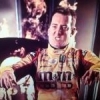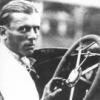1946 AAA Season (cont.-38) The above roster contains some peculiarities. The naming of Lou Rassey, as a driver, I surmize is a mistake. Rassey came to the Indianapolis fairgrounds with Elbert Booker as his pilot. Booker had been a somewhat prominent mid-western big-car and sprint pilot before World War II. Rassey had nominated Elbert for his 1946 Indianapolis entry but Booker failed his Speedway driving test so Rassey then put the veteran Henry Banks (1913-1994) in the cockpit for the "500". The R.C. Cott entry, with Snowberger as the chauffeur, was the Maserati with which Louis Unser "the old man of the mountain" (1896-1979), had just recently on 2 Sept. 1946, won the Pikes Peak hillclimb. The Barringer car had to be the rear-engined Miller which was quite unsuitable for dirt. In any case neither Barringer or Snowberger showed up. Barringer, of course, had been killed at Atlanta. Bill Corley tried to repair his broken car from the Atlanta race in time for the 100 miler at the Indiana Fairgrounds and had already hired Tony Bettenhausen to replaced the deceased George Robson, but the badly mangled 1938 Offenhauser/Wetteroth could not be fixed in time.
Instead Corley now somehow obtained Kelly Petillo's old 1935 Indy winner, possibly sitting vacant without an engine, and installed in it the Offenhauser motor out of Robson's wrecked vehicle. Petillo's machine was originally an Offenhauser/Wetteroth also, and it had been upgraded in 1939 and given a more modern body style. This car had been owned and driven by Petillo at Indianapolis during the years 1935 to 1941 inclusive. The new Corley entry now ran here at the Indianapolis Fairgrounds, and later at Milwaukee (Sept. 22), bearing the number "67" and with Bettenhausen as the pilot. On 14 Sept. 1946 it was announced in the Indianapolis papers that Floyd Eldon Davis, the 1941 co-Indy winner, would come out of retirement to pilot the Schoof Special. Davis was replacing the injured Billy DeVore and was also slated to drive this car at the upcoming Milwaukee 100 on 24 Sept. 1946. Davis had not been in competition since running the first 71 laps of the winning car at Indianapolis in 1941. Frank McGurk (1915-1982) was originally assigned this ride at Indianapolis but crashed the car on the front straightaway on 18 May 1946. After the vehicle was repaired Frank was unable to get the machine up to speed and quit the team. Billy DeVore then replaced McGurk in it and put the car into the starting field with a speed of 119.876 mph on the last qualifying day.
At the Indianapolis Fairgrounds, during the qualifications, and after Horn, Andres, and Connor had taken their runs, the next up was Al Putnam. On his third warmup lap Putnam lost control, took out 60 feet of the outer guard rail, and then crashed into a concrete or stone abutment of an overpass. Al was instantly killed when the steering column pierced his chest. Putnam had had a close call with death previously when he had crashed at Syracuse on September 1, 1940. His car had hit the rail and overturned several times. Al was thrown clear but sustained a severe head injury, a broken right arm, was in shock, and was unconscious for hours.
Putnam's racer Palmer Special No. 12 was very badly mangled on September 15, 1946 and its mechanic on that day, i.e. Cotton Henning, said that the only portion of the car that could possibly be saved was the engine. Al Putnam's Offenhauser/Stevens was the same machine he had used at Indianapolis, where he had been the slowest qualifier to actually make the race at 116.283 mph. The car was then owned by George L. Kuehn of Milwaukee, but sometime after the Indianapolis 500 mile race, it was sold to Richard L. Palmer, an Indianapolis automobile dealer.
This vehicle had originally been built for Harry Hartz for Ted Horn's use at the 1936 and 1937 Vanderbilt Cup races. Mike Boyle had subsequently acquired the car and under the Boyle marque Frank Wearne (1913-1985) had run it at Indy in 1940 and George Connor ran it there in 1941. This car was also, I believe, the same vehicle in which Babe Stapp won the 1939 Milwaukee 100 on August 27. The ownership of this Offenhauser/Stevens went from Harry Hartz, to Mike Boyle, to George Kuehn, and finally to Richard Palmer. Mays had driven it at Atlanta, as the Palmer Special No. 12, on September 2. In this instance Rex's usual Bowes Seal Fast No. 1, must either have failed to arrive or went out with mechanical ailments during one of the early practice sessions. Al Putnam (1910-1946) had been around. Al's resume shows four Indy starts, with his best finish being a 12th in 1941. Putnam occasionally ran elsewhere and his best placement in an AAA Championship contest was a 4th at Milwaukee in 1941. Putnam lived in Indianapolis, was a Mason in good standing, and worked at the L. G. S. Spring Clutch Company located in Indianapolis.
Rex Mays made the best qualifying time, 42.78 seconds or 87.083 mph, to start on the pole. In all, 13 cars posted times, but with three drivers killed in less than two races, the AAA got very careful, superstitious, and/or ridiculous. To avoid a 13 car starting field the AAA allowed Bardowski (1914-2000) to start after he had won a toss over the matter from Clarles Rogers (1917-2001). This incident, I believe, is indicative of the mental capacity of the 1946 AAA Contest Board officials. Bardowski however was flagged off the course, after running just 7 laps, as running too slow. Rex Mays took the lead in the first turn and led all 100 laps, it being noticed that his car was faster on the straightaways than any of his rivals. At 10 laps the running order was Mays, Andres, Horn, and Bettenhausen. At 50 miles the top four were Mays, Horn, Rose, and Andres; and at 70 laps the countdown was Mays, Horn, Rose, Andres, and Bettenhausen.
The order at the finish was Mays, Rose, Andres, Horn, and Bettenhausen. Floyd Davis, in the Schoof entry, was 7th and eight cars were still moving at the finish. Mauri Rose, in the Lencki 4 cylinder machine, started 6th and gradually bettered his positions. At 10 laps Mauri was 5th, 4th at 20 circuits, and up to 3rd by the half way mark or 50 miles. Rose moved into 2nd on lap 72 when he overhauled Horn on the front straight. At 100 miles, Rose remained in 2nd, but was almost a full lap behind Mays. Mays winning time was 1:16:03.43, his average speed 77..888 mph. This Indianapolis Fairgrounds contest was promoted by Dick Miller and Lou Moore. Moore sometimes ventured into race promotion. The officials of the Indiana State Fairgrounds did not take the death of Al Putnam lightly and would not allow another AAA Championship level event to be staged here until 26 Sept. 1953. The attentance here in 1946 was estimated at 20,000.
Edited by john glenn printz, 21 March 2012 - 17:29.













